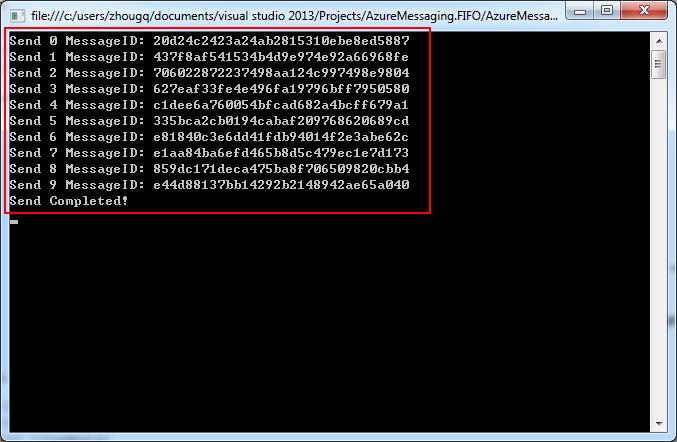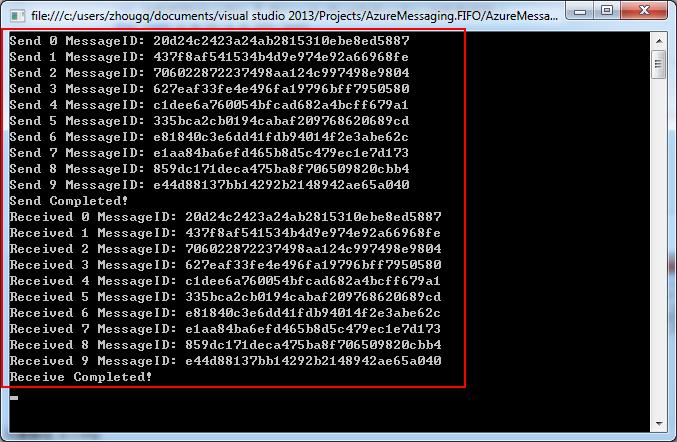Azure Messaging-ServiceBus Messaging消息队列技术系列3-消息顺序保证
Posted I love .net
tags:
篇首语:本文由小常识网(cha138.com)小编为大家整理,主要介绍了Azure Messaging-ServiceBus Messaging消息队列技术系列3-消息顺序保证相关的知识,希望对你有一定的参考价值。
上一篇:Window Azure ServiceBus Messaging消息队列技术系列2-编程SDK入门 http://www.cnblogs.com/tianqing/p/5944573.html
介绍了Azure Service Bus的编程SDK(主要的编程接口)
本文中我们以实际的使用场景来说明Azure Messaging是否支持以及如何编码实现:消息的收发顺序保证。
消息的收发在实际业务中往往是有顺序的:发送时1-2-3-4-5,接收时也必须是1-2-3-4-5,即FIFO特性。
在本文的Demo中,我们模拟销售订单消息队列异步处理场景,消息体是一条SalesOrder,顺序发送,顺序接收。
1. 我们还是使用上篇博客中在Windows Azure的Portal上建立好的NameSpace:servicebustest
销售订单队列名称:OrderQueue
2.简单封装一个Service Bus的工具类:ServiceBusUtils: 用于创建队列、删除队列、创建QueueClient、创建BrokerdMessage
using Microsoft.ServiceBus; using Microsoft.ServiceBus.Messaging; using System; using System.Collections.Generic; using System.Linq; using System.Runtime.Serialization; using System.Text; using System.Threading.Tasks; namespace AzureMessaging.FIFO { /// <summary> /// ServiceBus工具类 /// </summary> class ServiceBusUtils { //Namespace名称 private static readonly string namespaceName = "servicebustest"; /// <summary> /// 创建队列 /// </summary> /// <param name="queueName">队列名称</param> /// <param name="isSession">是否支持会话</param> public void CreateQueue(string queueName, bool isSession = true) { var namespaceClient = NamespaceManager.Create(); if (namespaceClient.QueueExists(queueName)) { namespaceClient.DeleteQueue(queueName); } var queue = new QueueDescription(queueName) { RequiresSession = isSession }; namespaceClient.CreateQueue(queue); } /// <summary> /// 删除队列 /// </summary> /// <param name="queueName">队列名称</param> public void DeleteQueue(string queueName) { var namespaceClient = NamespaceManager.Create(); if (namespaceClient.QueueExists(queueName)) { namespaceClient.DeleteQueue(queueName); } } /// <summary> /// 创建队列客户端 /// </summary> /// <returns>队列客户端</returns> public QueueClient GetQueueClient(string queueName, bool isSession = false, ReceiveMode mode = ReceiveMode.ReceiveAndDelete) { return QueueClient.Create(queueName, mode); } /// <summary> /// 创建队列客户端 /// </summary> /// <returns>队列客户端</returns> public QueueClient GetReceiveQueueClient(string queueName, ReceiveMode mode = ReceiveMode.PeekLock) { var namespaceClient = NamespaceManager.Create(); return QueueClient.Create(queueName, mode); } /// <summary> /// 构造消息 /// </summary> /// <param name="serializableObject">可序列化的对象</param> /// <returns>消息</returns> public BrokeredMessage Create(Object serializableObject) { var serializer = new DataContractSerializer(serializableObject.GetType(), new DataContractSerializerSettings() { IgnoreExtensionDataObject = true, PreserveObjectReferences = false }); var message = new BrokeredMessage(serializableObject); message.Properties.Add("Type", serializableObject.GetType().ToString()); return message; } } }
2. 示例SalesOrder实体类
using System; using System.Collections.Generic; using System.Linq; using System.Text; using System.Threading.Tasks; namespace AzureMessaging.FIFO { /// <summary> /// 销售订单类 /// </summary> public class SalesOrder { /// <summary> /// 订单ID /// </summary> public string OrderID { get; set; } /// <summary> /// 订单编号 /// </summary> public string Code { get; set; } /// <summary> /// 创建时间 /// </summary> public DateTime CreateTime { get; set; } /// <summary> /// 总价格 /// </summary> public Decimal TotalPrice { get; set; } /// <summary> /// 产品ID /// </summary> public int ProductID { get; set; } } }
3. 消息顺序发送
向OrderQueue发送10条消息订单消息,输出每条消息的顺序号以及MessageID
private static readonly string queueName = "OrderQueue"; /// <summary> /// 发送消息 /// </summary> private static void MessageSend() { var sbUtils = new ServiceBusUtils(); //创建队列 sbUtils.CreateQueue(queueName, false); //顺序发送消息到OrderQueue var queueSendClient = sbUtils.GetQueueClient(queueName); for (int i = 0; i < 10; i++) { var order = new SalesOrder() { OrderID = i.ToString(), Code = "SalesOrder_" + i, CreateTime = DateTime.Now, ProductID = 17967, TotalPrice = new decimal(19999) }; var message = sbUtils.Create(order); queueSendClient.Send(message); Console.WriteLine(string.Format("Send {0} Message: {1}", i, message.MessageId)); } Console.WriteLine("Send Completed!"); }
程序输出:

4. 消息顺序接收
消费OrderQueue中的消息,验证消息的接收顺序
private static readonly string queueName = "OrderQueue"; /// <summary> /// 接收消息 /// </summary> private static void MessageReceive() { int index = 0; BrokeredMessage msg = null; var sbUtils = new ServiceBusUtils(); var queueReveiveClient = sbUtils.GetReceiveQueueClient(queueName, ReceiveMode.ReceiveAndDelete); while ((msg = queueReveiveClient.Receive(TimeSpan.FromMilliseconds(3))) != null) { Console.WriteLine(string.Format("Received {0} Message: {1}", index, msg.MessageId)); index++; } ////删除队列 //sbUtils.DeleteQueue(queueName); Console.WriteLine("Receive Completed!"); }
程序输出:

可以看出,Azure Messaging中ServiceBus对消息的收发是有顺序保证的。
下一篇我们继续其他特性的验证和介绍。
周国庆
2017/3/9
以上是关于Azure Messaging-ServiceBus Messaging消息队列技术系列3-消息顺序保证的主要内容,如果未能解决你的问题,请参考以下文章